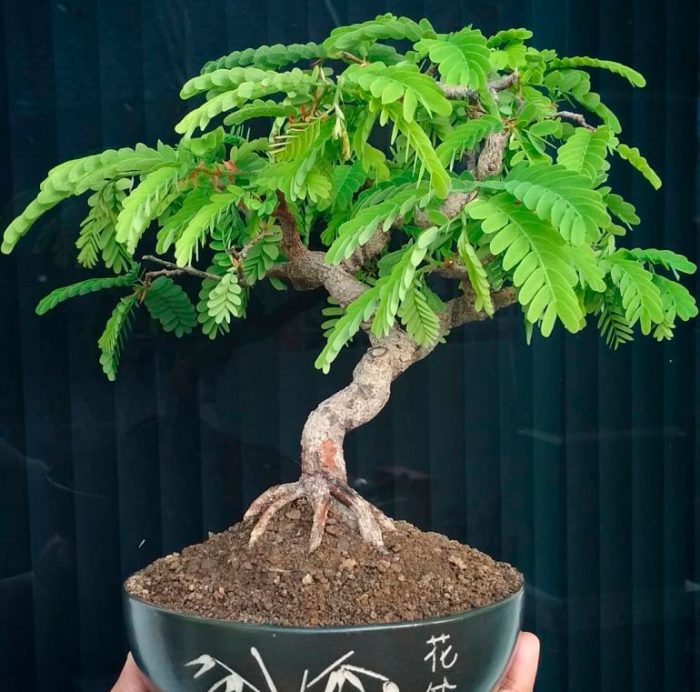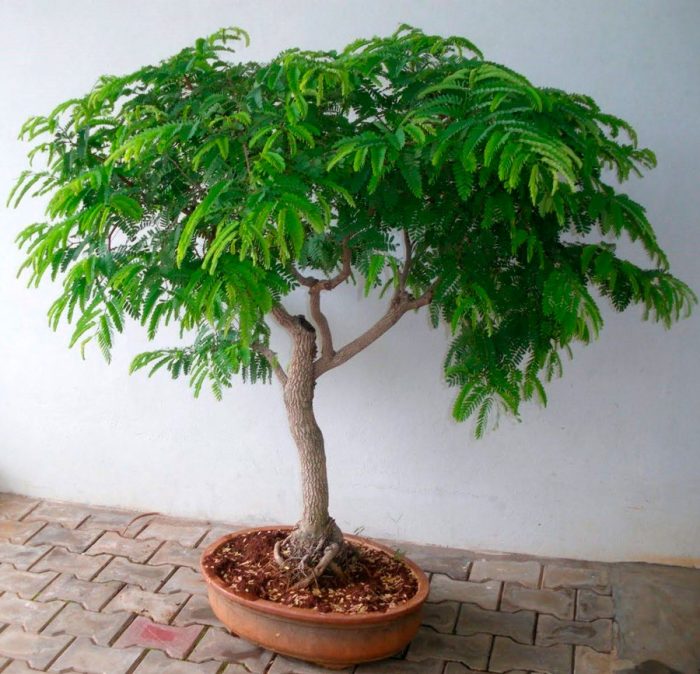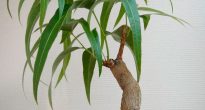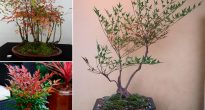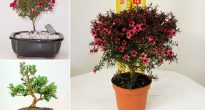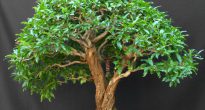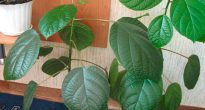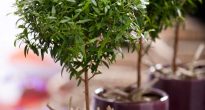Tamarind (Tamarindus) is a tree native to the tropics. It belongs to the legume family. In nature, a tree can reach a height of 25 m, but in indoor conditions it usually does not exceed 100 cm. This plant is one of the slow-growing ones. The leaf plates are pair-pinnate, and they contain from 10 to 30 separate thin leaves.
On tamarind, fruits are formed, which are beans, inside which there are a large number of dense seeds. This plant is native to eastern Africa. Today, in nature, it can be found in most of the tropical countries. However, tamarind gained such wide distribution thanks to its cultivation in the open field.
This perennial slow-growing plant is undemanding to care and growing conditions. Even a novice florist can handle it. Remember, homemade tamarind rarely blooms.
Content
Interesting facts about tamarind
Tamarind is a rather unusual plant. For example, his beans are edible, and they are added to a number of Asian dishes. In local markets in Asia, tamarind can be purchased salted, dried, frozen or candied if desired. In addition, the pulp of tamarind fruit is used to clean the surfaces of brass objects.
The wood of such a plant is distinguished by its high strength and density; it is often called "mahogany". It is widely used for the manufacture of parquet, furniture and a variety of interior elements. In India, this tree is planted along the sides of the roads, due to which chic shady alleys are formed over time.
Brief description of cultivation
Indoors, tamarind is often used for growing as a small compact tree, and it can also be used to form bonsai. It is quite simple to look after him:
- Temperature... In summer, it grows normally at room temperature, and in winter it should not fall below 10 degrees.
- Air humidity... Increased. Therefore, the tree must be moistened every day from a spray bottle.
- Illumination... The location should be sunny, with southern windows best suited.
- Watering... Moisten the substrate regularly and abundantly. In no case do not allow the earthen coma to dry out.
- Soil mixture... Should be fertile and loose. A little sand must be added to it.
- Fertilizer... Tamarind is fed in spring and summer with a frequency of 1 time in 7 days.
- Transfer... A young bush is transplanted as needed, and an adult is subjected to this procedure once every 2 or 3 years.
- Reproduction... Layers, seed method and stem cuttings.
- Pruning... It is carried out systematically in the spring.
Tamarind care at home
If you decide to decorate your home with a spectacular tamarind, then you need to study and remember a few simple rules for caring for it. If they are neglected, then this can lead to the death of the tree.
Bloom
Blooming indoor tamarind is a rarity. As a rule, the tree blooms in early December. At this time, brush-shaped inflorescences are formed on it, which consist of pink or yellow flowers.
Temperature
In spring and summer, the tree grows and develops best at temperatures from 23 to 25 degrees. At the same time, high air temperatures are not scary to him, since the hot tropics are his homeland. In winter, it is recommended to rearrange the bush in a cool and draft-free place.
Air humidity
The plant needs high humidity. That is why it is moistened daily in the morning and evening from a spray bottle, and this is done only in the warm season. Also, in order to increase the level of air humidity, it is recommended to put an open vessel filled with water near the bush.
Lighting
Indoor tamarind needs bright lighting. Moreover, the best choice for him will be the southern windowsill. To prevent the crown from being one-sided, the container with the bush is regularly rotated about 1/3 of its axis every 7 days.
Watering
Water the tree in such a way that the substrate in the pot is constantly slightly damp. Suitable water should be soft and warm.
Capacity and soil mixture
You can use both ceramic and plastic flower pots of a suitable size. The only prerequisite is the drainage holes at the bottom.
For planting and transplanting such a culture, you can take any of the ready-made universal soil mixtures sold in a specialized store. The main thing is that its acidity should be from 5.5 to 6.5.
Top dressing
Best of all, such a tropical plant responds to organic feeding. Fertilizers should be applied to the soil mixture once every 7 days. This is done only in the warm season, or rather, in May – September.
Transfer
An adult tree should be replanted in the spring months, but this is done only when necessary. While the bush is young, it grows quite actively and therefore it is transplanted annually.
Pruning
As a rule, during the winter months, tamarind is strongly stretched, and therefore pruning is carried out in the first days of March. Each shoot is shortened by 1/3 of the entire length.
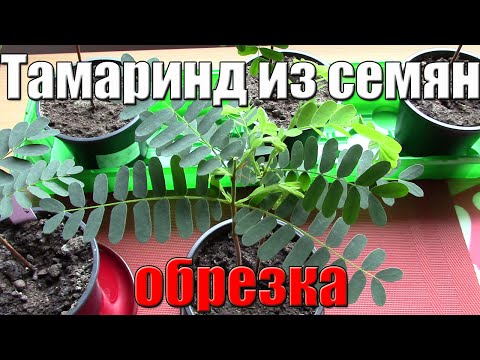

Watch this video on YouTube
Shaping bonsai
If you wish, you can form a bonsai from such a spectacular tree. In this case, he will need regular fertilizing with fertilizers with a high nitrogen content. After the height of the bush is 0.5-0.6 m, the top is trimmed. Then a trunk is formed, and after 12 months all leaf plates are cut off from the plant. Soon, the tree will again grow foliage, but it will be smaller.
Dormant period
Such a "tropical guest" has no rest period. Just in winter, so that the tree stretches less, it is transferred to a cool place.
Growing from seeds
Each tamarind seed is covered with a very dense, durable skin, so it will have to be sawed to speed up germination. Sowing is carried out in peat mixed with perlite. From above, the crops should be covered with clean river sand, the layer thickness is about 5 mm. Then they are removed to a warm, bright place, protected from direct sunlight. The first shoots should appear in about 20 days, and do not forget to systematically water the crops.The picking of plants into individual pots is carried out after they have formed feathery leaf plates.
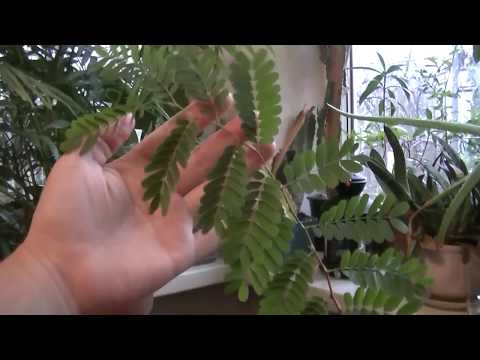

Watch this video on YouTube
Possible problems
With indoor tamarind, problems such as:
- Tamarind roots rot... It appears if the bush is in a cool place and at the same time liquid regularly stagnates in the soil mixture. Move the tree to a warmer place and check for drainage holes in the bottom of the pot.
- Tamarind leaves turn yellow and fall... This is due to the fact that the bush is watered very rarely or poorly. And also such changes with the plant occur in a room with dry air.
- Very slow growth... Tamarind lacks sunlight or nutrients. Transfer it to a sunny window and do not forget to fertilize the substrate in a timely manner.
Aphids, scale insects, spider mites and mealybugs most often settle on such a tree.


Watch this video on YouTube

